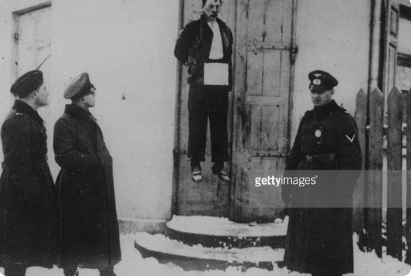In Dombrowa, Szurley, Bendzin 'and Sosnowiec
they are hanged publicly on gallows and trees;
the public, even schoolchildren, being driven to
look at these crimes.

During
the last months the Gestapo have intensified the terror very severely.
Their efforts are
directed towards the tracking down and extermination ofallsigns ofPolish
patriotic and freedom
activities. Throughout the country, and particularly in Poznan and
Warsaw, there is a ceaseless
wave of political arrests, and hardly anybody arrested is being released
; most of those arrested
are kept permanently in penal confinement under
the Gestapo, in ordinary prisons and in concentration camps ; many of
them, particularly in Western Poland and Pomerania, are executed by the
Gestapo shortly after their arrest.
The Gestapo men in Warsaw and Poznan are
specially distinguished by their cruelties.
The torture ofpersons under examination always
aims at the extraction of personal information or
concerning secret organizations, so that afterwards the Gestapo terror
may the more easily
seize upon fresh cases of patriotic activities and
fresh people.
The state ofthings in this sphere is so severe and
threatening that all possible means should be
taken to bring about an even partial relief and
mitigation of the situation.
News has been received of increased terror in
Upper Silesia. There are gallows in eighteen
Silesian towns. Those arrested are hanged.
In Dombrowa, Szurley, Bendzin 'and Sosnowiec
they are hanged publicly on gallows and trees;
the public, even schoolchildren, being driven to
look at these crimes.
In the concentration camp at Oświęcim itself
the number of prisoners held has risen in the course
ofthree months by 8,000.
The mass arrests concern especially Polish
officers of the reserve, Polish peasants who do not
deliverthe quota ofagricultural produce demanded
by the Germans, and Polish railwaymen and
workers accused of sabotage in their work.
A public execution of 100 Poles—of whom four
were women—was carried out at Zgierz, a town
near Lodz, on March 20th, in the presence of
7,000 people, for the killing of two Germans by a
Pole on March 7th. The bodies were beaten with
revolvers while still alive. This took place after
the public announcement that 10 Poles had been
shot for the killing of one German—and now the
rate is 50 for one.
On March 18th in the concentration camp of
Dziesiata, near Lublin (where there were formerly
i,i5oSoviet prisoners, ofwhom 950 were shot), 140
Polish political prisoners out of 800 imprisoned
there were shot. Among them were a number of
peasants imprisoned for delivering an insufficient
agricultural quota.
So we have 50 Poles shot at Zgierz, 100 in Warsaw, 105 in Jasnowiec, 400 near Lublin, and 540
near Radom, in each case for one German killed







.png)
Comments
Post a Comment